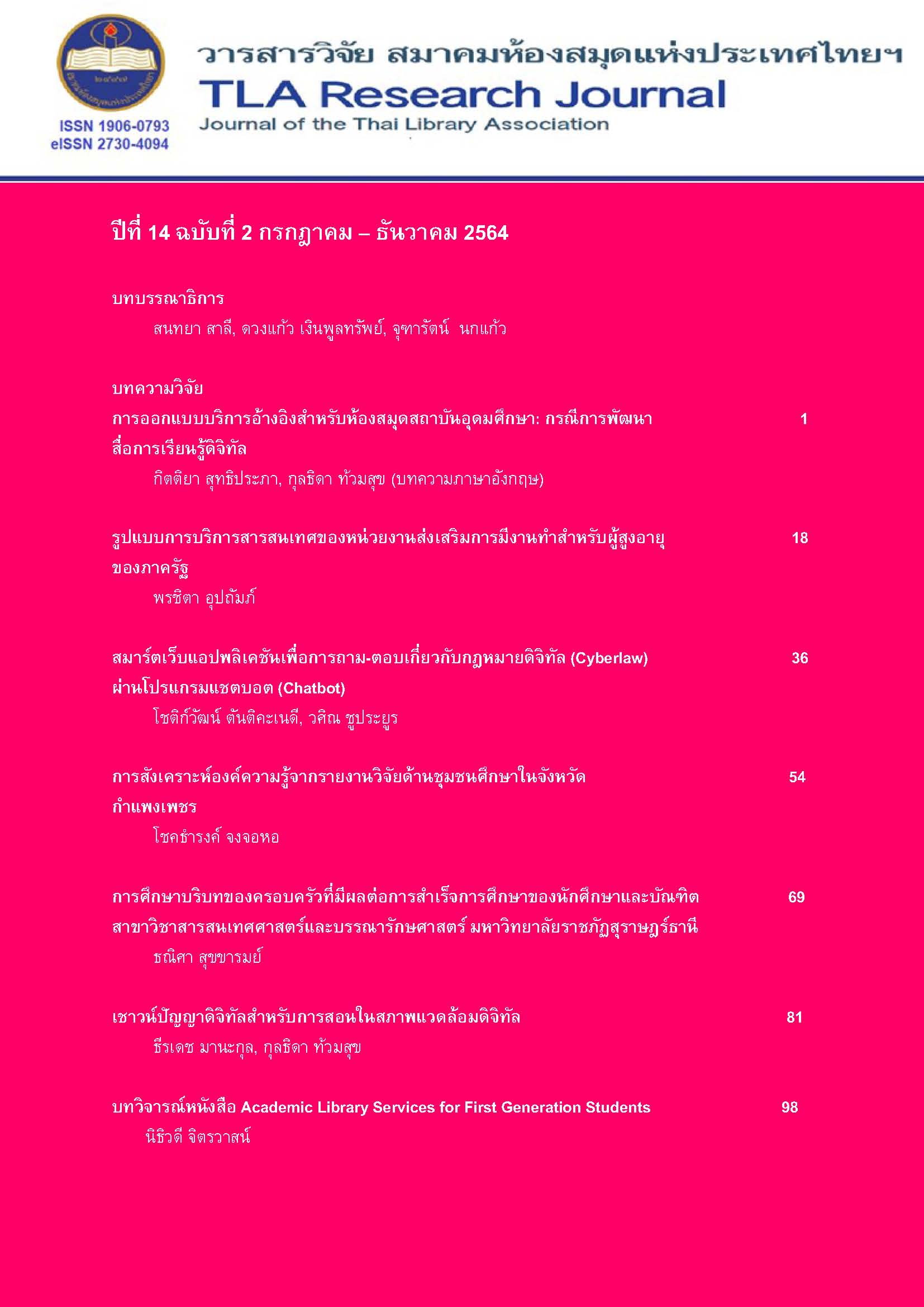chatbot,smartweb application A Smart Web Application for Cyberlaw Questions and Answers via a Chatbot Program
Main Article Content
Abstract
The objectives of this study are to (a) develop a smart web application that allows a chatbot program to answer digital law issues and (b) test the chatbot program and assess its efficiency and effectiveness. The scope of the questions and answers cited from 6 and related digital laws are (1) Copyright Act 1994 and 2015, (2) Computer Crime Act 2007 and 2017, (3) Cybersecurity Act 2019, (4) Personal Data Protection Act 2019, (5) Electronic Transactions Act 2001, 2008, and 2019, and (6) Patents Act 1979, 1992, and 1999. The findings yield an innovative Web application that can ask and answer the various digital law issues via the chatbot. This experiment simulated 200 questions and answers. The chatbot program was launched to the public for six months; during that period, the 385 samples were randomized to assess the program. The assessment found the high overall efficiency and effectiveness of the program . In addition, the samples highly satisfied the program. The hypothesis test using multiple linear regression analysis found that the program efficiency influences the effectiveness of the program in terms of a) keyword retrieval from the chatbot program database (R2 = .525), b) question and answer performance of the program (R2 = .519), and c) chatbot instruction to new questions (R2 = .507). The hypothesis test also found that efficiency influences user satisfaction regarding having a good feeling towards the program at 52.2% (R2 = .522), and effectiveness influences participation between chatbot and users at 76.7% (R2 = .767). The application and its chatbot are expected to become a new channel for digital law information search and assist the law library with a digital search on digital law contexts.
Article Details
บทความทุกเรื่องที่ลงตีพิมพ์จะได้รับการตรวจอ่านโดยผู้ทรงคุณวุฒิ ความคิดเห็นและบทความที่ปรากฏในวารสารนี้ เป็นของผู้เขียนซึ่งมิใช่เป็นความคิดเห็นของคณะผู้จัดทำ และมิใช่ความรับผิดชอบของสมาคมห้องสมุดแห่งประเทศไทยฯ การนำบทความในวารสารนี้ไปตีพิมพ์ซ้ำต้องได้รับอนุญาตจากคณะผู้จัดทำ
All articles submitted for publication will be reviewed by the academic reviewers. The editorial board and TLA claim no responsibility for the content or opinions expressed by the authors of individual articles or columns in this journal. Reprinting of any articles in this journal must be permitted by the editorial board.
References
Chanchaisilp, S., & Chooprayoon, V. (2020). Assessment of Efficiency, Effectiveness and Satisfaction in Chatbot Usability of the Banks in Thailand. RSU Library Journal, 26(1), 119-138 [In Thai].
Chung, M., Ko, E., Joung, H., & Kim, S. J. (2020). Chatbot e-service and customer satisfaction regarding luxury brands. Journal of Business Research, 117, 587–595. Retrieved from https://reader.elsevier.com/reader/sd/pii/S0148296318304776?token=0D86EC32146B139AD5FF8F49F4383F9320F70E857BC4BEE5834B9626D19EB8CE681B241BACC245B405F0D021E384DAED&originRegion=eu-west-1&originCreation=20210808055304
Cochran, W. G. (1953). Sampling Techniques. New YorK: John Wiley & Sons, Inc. doi:https://doi.org/10.2134/agronj1953.00021962004500120020x
Computer Crime Act (No 2), B.E. 2560 (2017). (2017, January 24th). Government Gazette, 134(10 Kor), pp. 24-35 [In Thai].
Computer Crime Act, B.E. 2550 (2007). (2007, June 18th). Government Gazette, 124(27 Kor), pp. 4-13.
Copyright law (No.2) B.E.2558. (2015, January 31). Government Gazette, 132(6 Kor), pp. 7-13 [In Thai].
Copyright law B.E.2537. (1994, December 9). Government Gazette, 111(59 Kor), pp. 1-12 [In Thai].
Cronbach, L. J. (1951). Coefficint Alpha and the Internal Structure of Tests. Psychometrika, 16(3), 297-334. doi:10-1007/bf02310555.
Cybersecurity Act, B.E. 2562 (2019). (2019, May 27th). Government Gazette, 136(69 Kor), pp. 20-51 [In Thai].
Dutta, P. (2020, November 10). Top 30 Best Chatbot Frameworks To Build Powerful AI Bots. Retrieved from ubuntupit: https://www.ubuntupit.com/best-chatbot-frameworks-to-build-powerful-ai-bots/
Electronic Transaction Act (No 3), B.E. 2562 (2019). (2019, April 14th). Government Gazette , pp. 12-26 [In Thai].
Electronic Transaction Act (No 4), B.E. 2562 (2019). (2019, May 22nd). Government Gazette , pp. 203-207 [In Thai].
Electronic Transactions Act, (No 2) B.E. 2551 (2008). (2008, February 13th). Government Gazette, 125(33 Kor), pp. 81-85 [In Thai].
Electronic Transactions Act, B.E. 2544 (2001). (2001, December 4th). Government Gazette, 118(112 Kor), pp. 26-42 [In Thai].
Jain, M., Kumar, P., Kota, R., & Patel, S. N. (2018). Evaluating and informing the dDesign of chatbots. DIS '18: Proceedings of the 2018 Designing Interactive Systems Conference (pp. 895–906). Hong Kong, China : Association for Computing Machinery. doi:doi.org/10.1145/3196709.3196735
Likert, R. (1932). A Technique for the Measurement of Attitudes. Archives of Psychology, 22(140), 5-55. Retrieved from https://legacy.voteview.com/pdf/Likert_1932.pdf
Patent Act (No 2), B.E. 2535 (1992). (1992, April 3rd). Government Gazette, 109(34), pp. 1-19 [In Thai].
Patent Act (No 3), B.E. 2542 (1999). (1999, March 31st). Government Gazette, 116(22 Kor), pp. 37-58 [In Thai].
Patent Act B.E. 2522 (1979). (1979, March 16th). Government Gazette, 96(35 Special), pp. 1-40.
Personal Data Protection Act B.E. 2562 (2019). (2019, May 27th). Government Gazette, 136(69 Kor), pp. 52-95 [In Thai].
Singh, R. (2019, January 20). 7 Ways chats Can Increase Business Efficiency and Productivity. Retrieved from Chatbots Magazine: https://chatbotsmagazine.com/7-ways-chatbots-can-increase-business-efficiency-and-productivity-707d284b96c5
TechTarget Contributor. (2019, August). Web application (Web app). Retrieved from Search Software Quality: https://searchsoftwarequality.techtarget.com/definition/Web-application-Web-app
Vyas, B. (2017, November 9). 6 key metrics to measure the performance of your chatbot. Retrieved from chatbotslife.com: https://chatbotslife.com/6-key-metrics-to-measure-the-performance-of-your-chatbot-5fd0adfd0b5b
What is a chatbot? (2019). Retrieved from ChatCompose: https://www.chatcompose.com/what-are-chatbots.html


